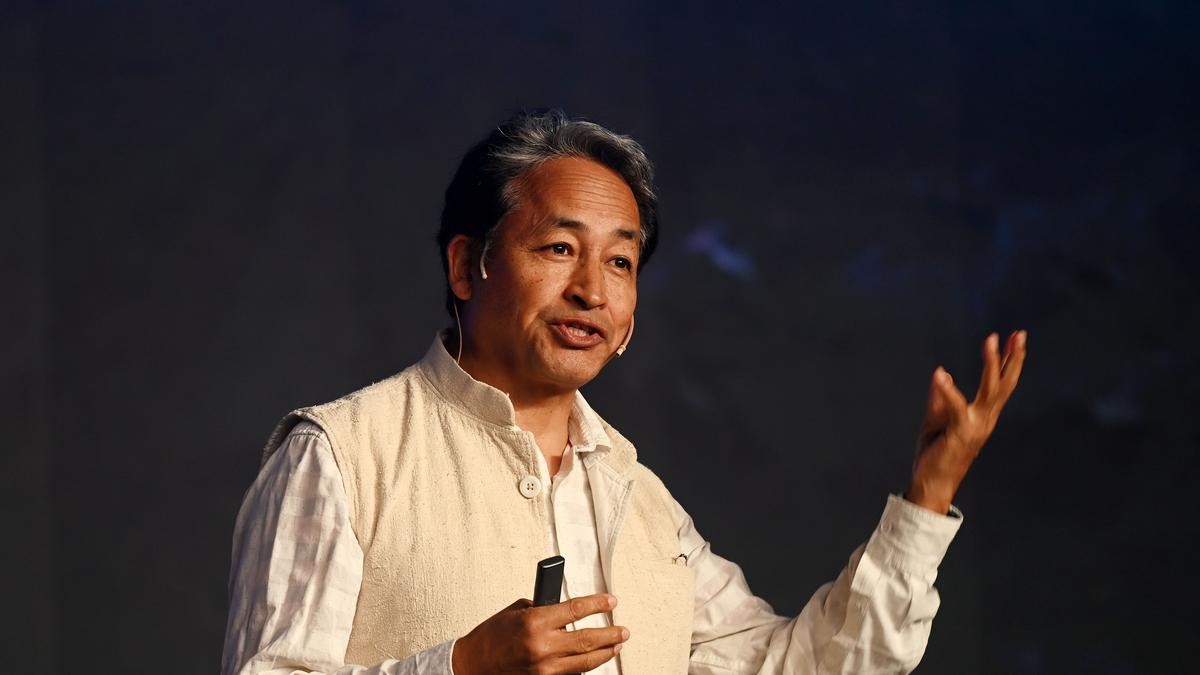The Need for a Himalayan Policy: Lessons from Sonam Wangchuk’s Call for Change
Syllabus:
- GS – 2 – Federalism in India, Distribution of power , Status of Schedule VI
- GS-3 – Climate change , role of cryosphere
Why in News ?
- The one-month, 1,000-km padyatra led by Sonam Wangchuk highlights the urgent need for a coherent national Himalayan policy.
Focus
- The article emphasizes the urgent need for India to develop a comprehensive Himalayan policy that balances environmental sustainability, democratic governance, and development. It highlights Sonam Wangchuk’s protest in Ladakh as a call for decentralization, Sixth Schedule status, and a new model of ecological democracy. The article also draws on Rammanohar Lohia’s vision of a unified Himalayan region.
Introduction: The Historic Leh to Delhi Padyatra
- Instead of engaging in dialogue, the government imposed Section 144 and detained protesters, signaling neglect of Himalayan issues.
- The ongoing protests, led by the Leh Apex Body and Kargil Democratic Alliance, represent wider concerns beyond Ladakh, impacting the entire Himalayan region.
Understanding the Himalayan Region’s Complexities
- Seemingly Isolated Incidents: Incidents like abrogation of Article 370 in Kashmir, landslides in Uttarakhand, flash floods in Sikkim, and violence in Manipur are interconnected and need a unified policy approach.
- Rammanohar Lohia’s Vision: Lohia emphasized the interconnections among Himalayan states and advocated for a democratic and inclusive Himalayan policy, which remains relevant today.
Rammanohar Lohia’s “Himalayan Policy”
- Political Dimensions:Lohia recognized that external threats, such as Chinese aggression, and internal challenges like ethnic violence, required an integrated approach.
- Democratic Rights: He stood for the democratic rights of people in the Himalayan regions within and outside India, urging democratic engagement with rebels in Kashmir and Nagaland.
- Opposition to Nehru: Lohia opposed Nehru’s foreign policy, which he believed overlooked the growing threat of Chinese expansionism.
The Need for a Contemporary Himalayan Policy
- Current Relevance: The challenges in the Himalayan region today, including environmental degradation, geopolitical tensions, and ethnic violence, necessitate a policy that balances development, environmental sustainability, and democratic governance.
- Multiple Unities: Lohia envisioned unities across the Himalayan people, neighboring countries, and the region’s culture, which must be a guiding principle for modern policies.
Ladakh’s Struggle for Democratic Governance
- Demand for Statehood or Autonomy:Ladakh’s citizens are demanding either full statehood or Union Territory (UT) status with an elected legislature, like Delhi or Puducherry.
- Sixth Schedule Status:The primary demand of the march is the implementation of the Sixth Schedule to empower local communities and grant them autonomy over internal governance through Autonomous District Councils.
- Geopolitical Significance: Despite Ladakh’s small population of around 3 lakh, the region’s strategic importance due to its size and location requires political representation in the Lok Sabha and Rajya Sabha.
Decentralization and Empowerment in Ladakh
- Autonomous District Councils: Wangchuk and his colleagues advocate for decentralization, with each district in Ladakh governed by its own council, ensuring that smaller tribal communities can preserve their identities.
- Promise from the BJP: This demand was also a part of the BJP’s electoral manifesto, but it remains unfulfilled, prompting the current protests.
Ecological Democracy and Development in Ladakh
- Sustainable Development: Wangchuk’s movement goes beyond political autonomy; it calls for an “ecological democracy” that respects local culture and the environment.
- Opposition to Indiscriminate Projects: While opposing large hydropower projects that threaten the environment, Wangchuk is not against development itself, advocating for sustainable and community-centered progress.
- Pedagogy and Local Context: Wangchuk, a Ramon Magsaysay Award-winning educator, also promotes an education system rooted in local traditions and needs.
Wangchuk’s Moral Protest and Gandhian Ideals
- Moral Equation: Wangchuk’s protest echoes Gandhian principles of non-violent resistance, persistence, and moral integrity, positioning himself not as an aggressor but as a voice for the voiceless.
- Delhi’s Response: The state’s inability to handle Wangchuk’s peaceful protest reflects a deeper disconnect between the central government and the aspirations of the people in the Himalayan region.
- Traditional Wisdom: Wangchuk questions the modern claims of superiority in governance and development, offering alternative models based on traditional Himalayan wisdom.
The Broader Significance of a Himalayan Policy
- Environmental Vulnerability: The fragile Himalayan ecosystem, prone to landslides, flash floods, and other natural disasters, demands a policy that prioritizes sustainable practices and human security over geopolitics.
- Human Security: The shift in focus from national security to human security emphasizes the need to address the developmental aspirations and rights of the Himalayan people, not just through military presence but by fostering inclusive development.
- Cultural and Natural Resources: The region’s wealth of biodiversity, water resources, and sustainable livelihood practices must be harnessed while preserving local communities’ cultural identities.
The Demand for Sixth Schedule Status
- Empowerment of Tribal Communities: Granting Sixth Schedule status would allow greater autonomy to local tribal communities and provide a framework for self-governance and cultural preservation.
- Failure to Fulfill Promises: Despite being promised by political parties, including the BJP, the delay in implementing Sixth Schedule provisions has led to widespread frustration and protests.
Sonam Wangchuk’s Call for Dialogue
- Indefinite Fast: Wangchuk’s fast, started on October 15, 2024, symbolizes his call for dialogue with India’s top leadership. His demands include a meeting with the Prime Minister, Home Minister, or President to discuss Ladakh’s issues.
- A Moral Appeal: Wangchuk brings the concerns of the Himalayas to the nation’s capital, urging political leaders to listen to the region before the “Himalayan fury” manifests in the form of environmental or geopolitical crises.
Conclusion: The Himalayas Demand Attention
- Policy Shift: The article calls for a shift in how the Indian state views the Himalayas—not just as a geographic region but as a collective of people with unique aspirations, needs, and wisdom.
- A New Vision for Development: The Himalayas are not just a source of natural beauty; they represent a new model of development, ecological wisdom, and sustainable living that the rest of the nation can learn from.
- Listening to the Himalayas: The message is clear: If the Indian government does not pay attention to the region’s demands, it risks being caught off guard by both natural and human challenges in the near future.
Associated Article
https://universalinstitutions.com/navigating-ladakhs-border-complexities/
Mains UPSC Question GS 3
Discuss the importance of a comprehensive Himalayan policy for India, considering the political, environmental, and cultural challenges of the region. How do the recent protests in Ladakh, led by Sonam Wangchuk, highlight the need for decentralized governance and sustainable development? (250 words).





